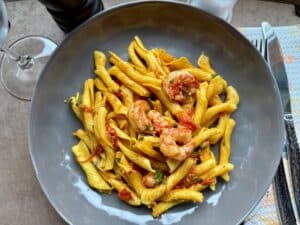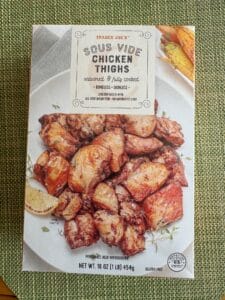
Ah, Trader Joe’s Kimbap — the latest culinary ‘adventure’ from our beloved grocery chain known for its quirky takes on international cuisine. As I approached this product, nestled between ‘authentically inauthentic’ frozen meals and snacks, I couldn’t help but wonder: Would this be a triumphant fusion of convenience and Korean delicacy, or just another aisle of disappointment? With a mix of skepticism and curiosity, I prepared myself to embark on a taste test journey, armed with nothing but chopsticks and my discerning palate.
Trader Joe’s Kimbap had gotten a lot of attention already on Reddit, Facebook, and Tiktok so I don’t want to step on anyone’s toes here. I am just going to give you my honest review about a product that I know nothing about historically. All I know is that when I have Korean food, I love it.

Having said that this is Trader Joe’s and it’s fair game and I don’t really have a cultural perspective to bring to it, I will tell you if I like it. Simple as that. I’m coming at it with no cultural baggage so if I like it, I’ll tell you. (rant over)
What is Kimbap (Gimbap)?
Kimbap or Gimbap, spelling changes from place to place but is essentially the same thing, is a take on Japanese norimaki which is basically a long tube of rice with nori (seaweed) wrapped on the outside. What goes in the middle is open to interpretation depending on where you are. In Japan, it is frequently sushi (raw fish) but can be a wide variety of things from vegetables to eggs.
Kimbap is basically the same thing. The rice is prepared slightly differently and what goes in the middle has a Korean flair. Pickled vegetables, fish, meats, and even cheese in some versions. It is generally used for fast food or lunch. Often served with hot sauce or mayonnaise, or soy sauce to dip them into.
In my poking around the internet, it seems that Kimbap is mostly eaten at room temperature but there are variations where it is pan fried or even dipped in a batter and deep fried.
Mostly, it just looks like one of the healthiest foods I can think of and I wish it was more widely available because I would eat it for lunch every day!

How To Prepare Trader Joe’s Kimbap
Trader Joe’s doesn’t give us many options to prepare this Kimbap roll, basically, you cut off an end to the plastic wrap and microwave for two minutes. If you are interested in their full directions, I will paste them below:
HEATING INSTRUCTIONS: HEAT FROM FROZEN. DO NOT THAW.
MICROWAVE (1200 watt):
Microwave heat times may vary depending on oven wattage.
- Cut the corner of the package.
- Heat on high for 2 minutes.
- Let stand for 1 minute.
- Remove Kimbap from the package.
Can be enjoyed hot or cold once heated from frozen.
For a crispy texture, heat a teaspoon of oil in a pan over medium heat.
Carefully add the kimbap to the skillet and pan-fry for 2 to 3 minutes on each side.
That is an interesting idea there at the end of the directions. I would take the kimbap directly from frozen and fry it in a nonstick pan with a little neutral oil for a couple of minutes on each side. Something to try the next time I buy it.

How to eat Trader Joe’s Kimbap
After you heat up the Kimbap, it will still be in the plastic tube wrap so be careful removing it from the wrap. It will be very hot. You have a couple of choices from here. Pull it out and let it cool off or eat it hot. I choose a middle route and let it cool off a bit but it was still warm when I started eating it. It looked pretty bland so I served it with Trader Joe’s soy sauce to dip it into.
The Kimbap is conveniently pre-cut for you, making this very easy to eat right out of the plastic tray it comes in.
I just used chopsticks to grab each piece and dip it in the soy sauce, but I did pull a couple of them out of the tray for the glamour shot.
Several of the pieces did fall apart when I tried to grab them which made for a messy experience but it is what it is. How many of you have had sushi fall apart when you eat it?

The Review of Trader Joe’s Kimbap
I think Trader Joe’s has a hit on their hands just for the same reason the Middle Eastern Style Kebabs were a hit, they’ve tapped into a dish that is very near and dear to a lot of people from a certain area of the world. Just for that reason, I think almost every Korean American near Trader Joe’s will probably try it once.
This is a product made in Korea and Trader Joe’s even states on their website that it comes from a producer of Kimbap in Korea so it’s pretty authentic.
They list this as three servings at 140 calories each or about 420 calories for a whole container. On the downside, eating a whole thing of them is 980 mg of sodium, which is almost half of your daily intake of sodium. Dip them in some soy sauce and you are going way over your daily allowance. Just something to think about. I didn’t think they tasted overly salty or out of the ordinary.
The other thing I wanted to bring up was the fact these Trader Joe’s Kimbap is vegan as far as I can tell. I poured over the ingredients list and I couldn’t find anything remotely animal related. The protein element in this food is tofu and there is nothing else except plants and oil. Honestly, I couldn’t tell. The tofu had a nice meaty appearance to it. Almost like diced chicken.
At the end of the day, I really appreciated Trader Joe’s take on Kimbap! It was easy to make. The whole container was enough for me for a meal. You can doctor it up with your favorite dipping sauces or even fry it in oil if you want for some more crunch. The tofu and burdock root make for an interesting crunch and protein element in the middle. The rest of the vegetables also contributed to a nice color and flavor profile. The only downside is that each round was a little fragile and I had a couple of them fall apart but as anyone who has been to a sushi restaurant knows these things can fall apart.
I will probably be buying a few of these and for $3.99 it sure makes a cheap meal and is perfect for taking to the office for a super simple lunch.
FYI, there is a lot of talking about if this is a gluten free product or not. After a little digging on the internet, I found that there are no ingredients listed that have gluten and there was a mention of someone emailing Trader Joe’s customer support and they said that it doesn’t contain gluten, but they can’t put it on the label because it’s not certified.
I am going to rate Trader Joe’s Kimbap 8 out of 10 Bells!

Ingredients
SEASONED RICE (WATER, RICE, SESAME OIL, SALT, TOASTED SESAME SEEDS, SOYBEAN OIL, DISTILLED VINEGAR), FRIED TOFU AND BRAISED BURDOCK (WATER, SLICED FRIED TOFU [SOYBEANS, WATER, SOYBEAN OIL, CALCIUM CHLORIDE, CANOLA OIL, CALCIUM CARBONATE], BURDOCK ROOT, CORN SYRUP, SOY SAUCE [WATER, FERMENTED SOYBEANS, SALT], CANE SUGAR), STIR-FRIED CARROT (CARROT, SOYBEAN OIL, SALT), PICKLED RADISH (SALTED RADISH [RADISH, SALT], CANE SUGAR, WATER, DISTILLED VINEGAR, SALT, LEMON CONCENTRATE), SEASONED SPINACH (SPINACH, SESAME OIL, TOASTED SESAME SEEDS, SALT), SEAWEED.
- CONTAINS SOY, SESAME.




[…] everything I review can be a hit like the Squiggly Cut Noodles or the Kimbap, we sometimes must eat just some regular food and one of my favorite meals is breakfast! I love […]